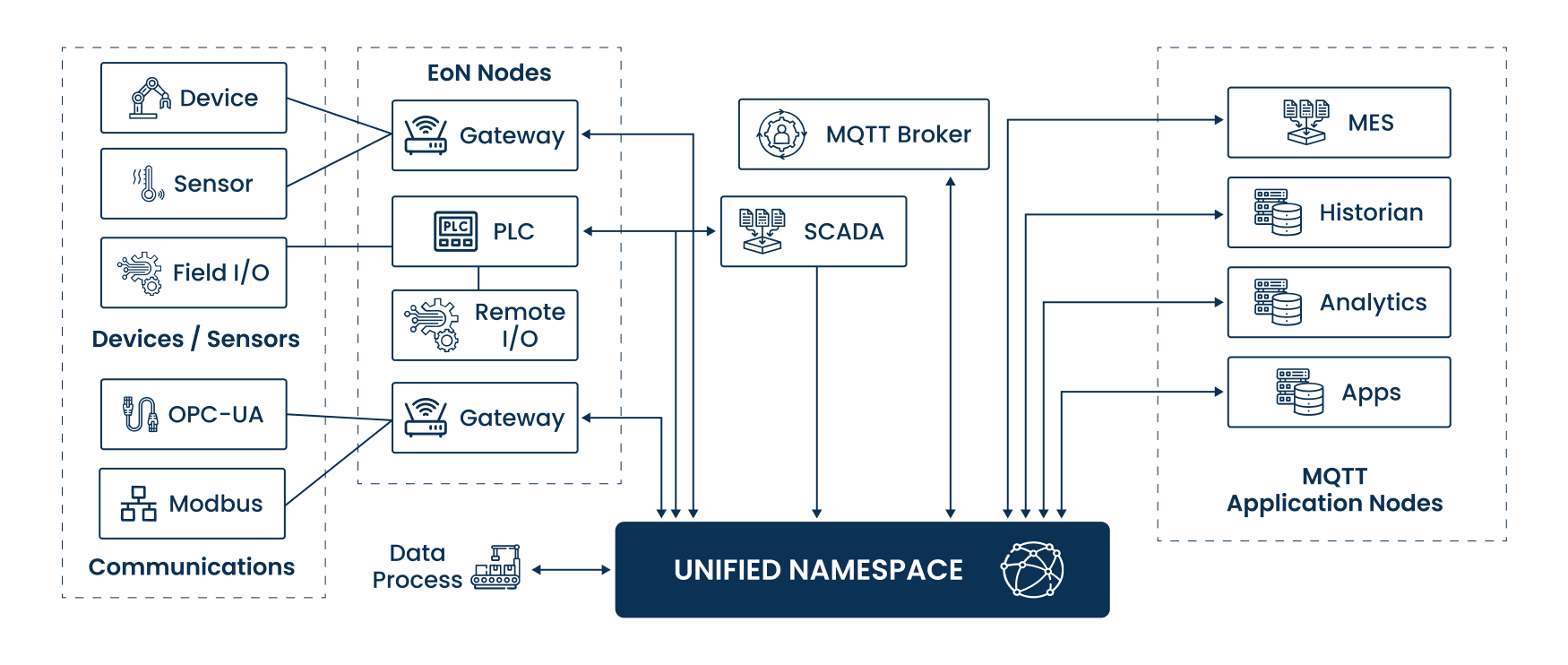Unlock Seamless Data Flow: Embracing the Unified Namespace Architecture
In today's dynamic manufacturing landscape, data is the lifeblood of efficiency, agility,
and innovation. However, the reality for many manufacturers is a fragmented data
landscape – disparate systems, isolated silos, and a constant struggle to gain a
holistic view of their operations. Enter the Unified Namespace (UNS), an architectural
pattern that promises to break down these barriers and usher in an era of seamless data
flow.
Imagine a central nervous system for your entire manufacturing operation. That's
essentially what a Unified Namespace provides – a single, logical, and hierarchical
structure that organizes all your operational data, from the shop floor to the
enterprise level. Instead of applications directly communicating with individual devices
and systems, they interact with this central namespace, subscribing to the data they
need and publishing the data they generate.
The Compelling Advantages of a Unified Namespace
Adopting a Unified Namespace offers a wealth of benefits for manufacturing industries:
- Enhanced Data Visibility and Context: By centralizing data and providing a
consistent naming convention, a UNS offers unparalleled visibility into your entire
operation. You gain a holistic understanding of production processes, asset
performance, quality control, and more, all within a unified context. This empowers
better decision-making and faster problem-solving.
- Simplified Integration and Interoperability: Say goodbye to complex
point-to-point
integrations! A UNS acts as a decoupling layer, making it significantly easier to
integrate new systems and applications. Different technologies and protocols can
seamlessly exchange information through the central namespace, fostering greater
interoperability.
- Improved Scalability and Flexibility: As your manufacturing operations evolve
and
grow, a UNS provides a flexible and scalable foundation. Adding new devices,
machines, or systems becomes a much simpler process, as they only need to interact
with the central namespace.
-
Real-time Data Availability for Analytics and Insights: With all critical
data
readily available in a structured format, leveraging advanced analytics, AI, and
machine learning becomes significantly easier. Real-time insights can be derived to
optimize processes, predict maintenance needs, improve quality, and drive continuous
improvement.
-
Empowered Edge Computing: A UNS facilitates the deployment of edge computing
solutions. Data can be processed closer to the source, and only relevant information
is published to the central namespace, reducing network latency and improving
real-time control.

Navigating the Challenges of UNS Adoption in Manufacturing
While the benefits are clear, adopting a Unified Namespace in manufacturing isn't without
its challenges:
- Legacy System Integration: Many manufacturing facilities have a significant
installed base of legacy equipment and systems that may not readily support modern
communication protocols or easily integrate with a UNS.
- Data Governance and Standardization: Establishing consistent data naming
conventions, data quality standards, and robust governance policies across diverse
operational technology (OT) and information technology (IT) systems can be a complex
undertaking.
- Security Considerations: Centralizing data in a UNS requires careful
consideration
of security implications. Robust cybersecurity measures are crucial to protect
sensitive operational data from unauthorized access and cyber threats.
- Skills Gap and Training: Implementing and managing a UNS requires a skilled
workforce with expertise in both OT and IT domains. Addressing the potential skills
gap through training and development is essential.
- Organizational Culture and Collaboration: Successful UNS adoption requires
strong
collaboration between OT and IT teams, which may have historically operated in
silos. Fostering a culture of data sharing and collaboration is critical.
Guidelines to Overcome Adoption Challenges
Here's a roadmap to navigate these challenges and successfully implement a Unified
Namespace:
- Start with a Phased Approach: Instead of a big-bang implementation, begin
with a
pilot project in a specific area of your manufacturing operation. This allows you to
learn, refine your approach, and demonstrate the value of the UNS before a
full-scale deployment.
- Prioritize Data Governance: Establish clear data ownership, naming
conventions, data
quality standards, and access control policies from the outset. Involve both OT and
IT stakeholders in defining these guidelines.
- Focus on Secure Integration: Implement robust security measures at every
layer of
the UNS architecture, including network segmentation, access controls, encryption,
and continuous monitoring.
- Invest in Training and Upskilling: Provide comprehensive training to your OT
and
IT teams on the principles, technologies, and best practices associated with the
Unified Namespace. Consider bringing in external expertise to support the initial
implementation.
- Foster OT/IT Collaboration: Establish clear communication channels and
collaborative workflows between OT and IT teams. Encourage cross-functional teams to
work together on the UNS implementation and ongoing management.
- Choose the Right Technology: Select technologies and protocols that align
with
your existing infrastructure and future needs. Consider open standards and widely
adopted protocols to ensure interoperability.
The Pivotal Role of MQTT
MQTT (Message Queuing Telemetry Transport) plays a significant role in enabling the
Unified Namespace architecture, particularly in industrial environments. Its lightweight
nature, publish/subscribe messaging model, and efficient handling of intermittent
connections make it ideal for connecting a wide range of industrial devices and sensors.
Importance of MQTT in UNS:
- Efficient Data Transmission: MQTT's low bandwidth consumption and efficient
message
handling make it well-suited for transmitting data from resource-constrained devices
over potentially unreliable industrial networks.
- Decoupled Communication: The publish/subscribe model decouples data producers
from
consumers. Devices publish data to specific topics within the UNS, and applications
subscribe to the topics they are interested in, without needing direct knowledge of
each other.
- Scalability and Flexibility: MQTT's architecture can easily scale to
accommodate a
large number of devices and applications. Adding new data sources or consumers is
straightforward.
- Real-time Data Availability: MQTT facilitates the near real-time transmission
of
operational data to the UNS, enabling timely insights and responsive control
actions.
Maestro: Your Partner in Unified Namespace Adoption
At Maestro, we understand the transformative potential of the Unified Namespace for
manufacturing industries. Our team of experienced OT and IT professionals possesses the
deep expertise to guide you through every step of your UNS journey.
We can help you with:
- Assessment and Strategy: Evaluating your current infrastructure and
developing a
tailored UNS adoption strategy aligned with your business goals.
- Architecture and Design: Designing a robust and scalable Unified Namespace
architecture that meets your specific requirements.
- Implementation and Integration: Seamlessly integrating your existing systems
and
deploying the necessary technologies.
- Data Governance and Security: Establishing best practices for data governance
and
implementing comprehensive security measures.
- Training and Support: Empowering your team with the knowledge and skills to
manage
and maintain your Unified Namespace.
Ready to unlock the power of seamless data flow and transform your manufacturing
operations?
Contact Maestro today to explore how a Unified Namespace
architecture can
drive efficiency, innovation, and growth for your business. Let us be your trusted
partner in building a connected and intelligent manufacturing future.


